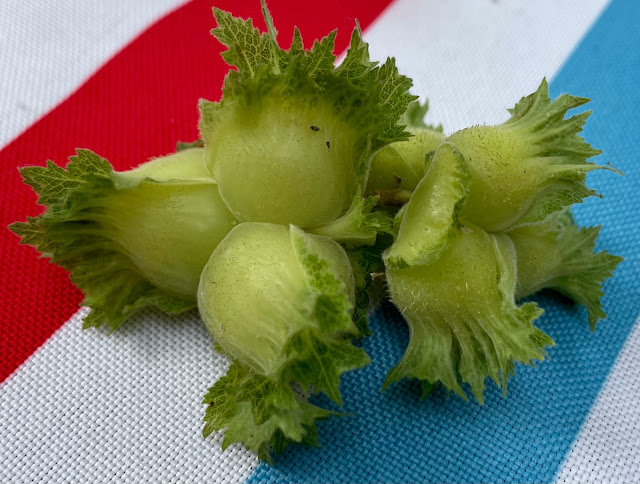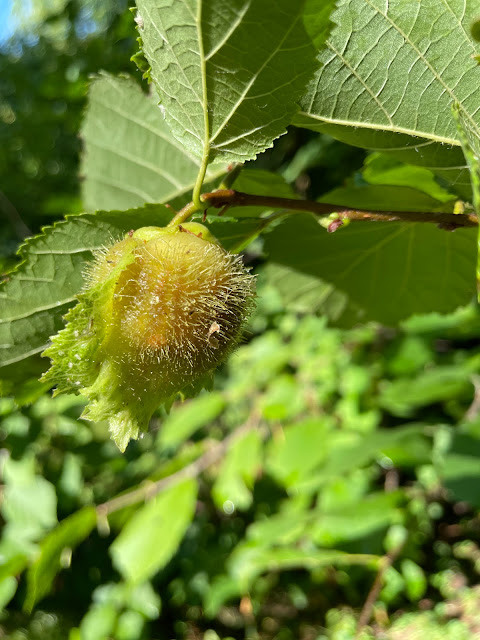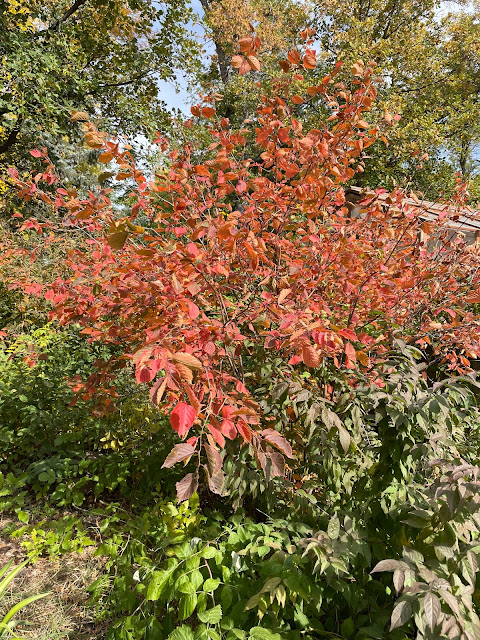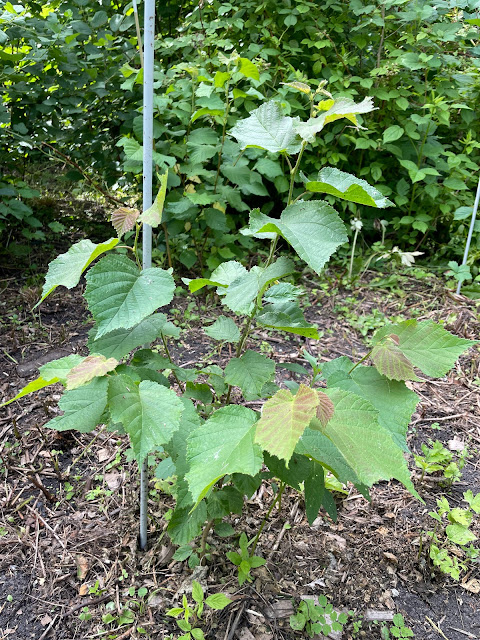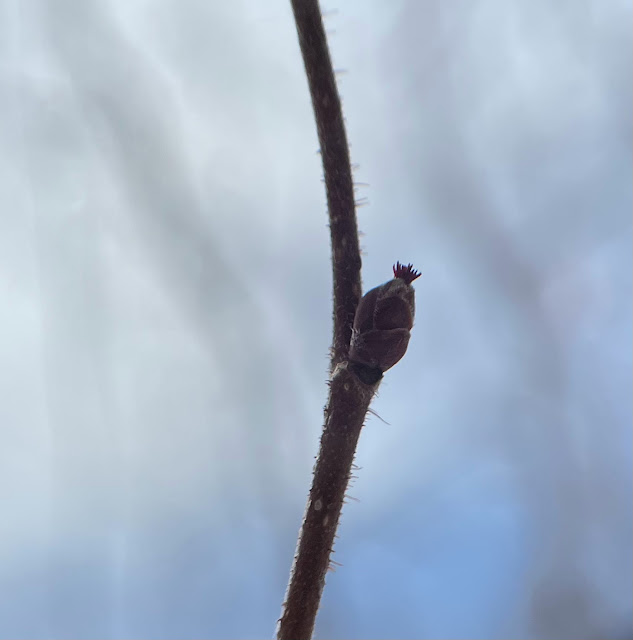Sibley State Park
We were camping in Sibley state park in Minnesota on July 12th, and found these hazelnut plants growing on a hiking trail. I was not surprised to find hazelnut plants in the park, but as we hiked the trail I found several different types of hazelnut plants that look almost completely different. The next pictures shows the different types of husks or involucres on these plants.
On this plant the husk was open showing the nut in side.
The husk on this hazelnut plant had small sticky hairs, which might detour the squirrels and chipmunks.
On this plant the nut was enclosed with a very thick juicy husk around it.
The husk on this one was very short with some small red hairs and a slight reddish color.
This plant has these large leafy husks. These were a little hard to find because they resembled the leaves that were covering them.
I was so surprised by the very large leafy husks on this plant.
This small slightly open husk covering a very small nut with sticky little hairs. All these hazelnut plants are the American Hazelnut (Corylus americana) and they form a thick suckering shrub about 5 feet high.
These are beaked hazelnuts (Corylus Cornuta) which is also bushy shrub, but seem to be taller about 6 to 7 feet. As you can see they have a long leafy beak shape husk. I was just amazed that there are so many variations of hazelnut husks in such a small area.
Maplewood State Park

On October 5th we visited Maplewood state park and found these hazelnut plants. The nuts were long gone probably remove by the many squirrels and chipmunks that were everywhere.
They had a very dark marroon color and a catkin, the male flower, laying on one leaf. The catkins appear on the plant in the late summer and will open in the spring to release their pollen
This is another picture of the same plant. The hazelnut shrub was very short about 3 to 4 feet high with very thin stems and lots of small suckering stems coming up around the plant.
This would not be a plant you would want in your garden or back yard, but would be great for a riparian buffer zone along a river to hold the river bank from washing away.
Hazelnut from flower to mature nut
I wanted to show a developing nut from flowering to a mature nut, so I took pictures of the same branch during the spring, summer, and fall.
April 18th the female flower appeared on a bud and below the male flowers or catkin began to open up and release their pollen.
It is June 3rd and the husk and nuts are just starting to develop on the end of this new stem.
There is a delay of over a month or more between when the pollen is received and when the embryo is fertilized and starts to develop.
July 7th and the new nuts can be seen in the husk. In July the shell of the nut will grow to its full size, but it will take another month for the kernel to fill the shell.
28-Aug and the kernel has filled the shell but the kernel contains mostly water and in the next week or two will be replaced with oil. If the nut were picked now the husk would not release the nut and the kernel would shrivel when dried and look like a raisin.
Sept 1st and the nut's abscission layer has form and now can easy be removed from the husk.
The nut cluster also has an abscission layer forming and can be removed from the branch with limited damage to the plant. The nut clusters will fall to the ground in another week if not remove by some furry varmit.
Here is another cluster of nuts from that same plant.
Harvest started on the 28 of August this year and finished on 20th of September.
Because of the many different varieties in the orchard no more then 1 or 2 plants are ripe at the same time.
This is great for me because I wouldn't be able to pick over 300 plants in 2 days. For a commercial orchard to make money this would not be ideal because each plant would have to be checked to make sure the nuts were mature and ready to be picked. In Oregon all the plants in an area ripen at the same time because they are the same cloned plant in one field except for a few different types that are used for pollination. Hazelnuts are not self pollinating and need a different varity for pollination.
Harvest 2022
July 22, harvest wasn't even close and the squirrels started stripping the immature hazelnuts off the plants.
I think this was due to the bumper crop of hazelnuts and the lack of oak acorns and black walnuts.
I'm just guessing but I think I lost over 75 pounds of nuts to the squirrels.

During harvest I usually find some unusual husks. This plant had these very long almost beak like husks.
Here are what the nuts looked like from these long husks.
I did have a few problems with this husk because when the husk was dried down it enclosed the nut and would not release it.
On some plants you can tell if is ready to be picked by the brown color of the husk.
To be sure I always make sure the nut rolls out of the husks.
Not all husks turn brown to indicate it's ripe. On this plant the husk stays green even though the nut is mature and rolls out of the husk. Every year I record the date specific plants are ripe, so I have a good idea when to pick certain plants.
This plant has 8 to 12 nuts in a cluster, and they are so tightly pack that the nuts never drop out of the husk. In a few days the plant will drop the whole cluster and still the nuts are hard to remove from the cluster. Also some of the nuts in the clusters are very small. I prefer only 4 nuts in a cluster so this plant might have to be eliminated even though it's a heavy producer of nuts every year.
This plant just has singles with no clusters and a round very sticky husk and large nut.
The positive side of this plant is the squirrels tend to leave alone.
This is another plant that just started producing these large single nuts that drop out of the husk when dried down. I'll have to evaluate this plant for a couple years to see how many nuts it will produce. I'm always excited to see a new plant that produces a nice round nut.
September 7th and almost done with harvest only 5 more plants to go.
As you can see my greenhouse turns into a large drying rack.
The greenhouse has good airflow with the fans and venting and the big plus is it protects the nuts from squirrels and mice.
This allows me to remove the dried husk in just a few days and put the nuts into storage.
I'm also keeping the hazelnuts from each plant separated to evaluate and record each one. That way I can eliminate the undesirable plants. I try to remove about a hundred plants every year and plant new and hopefully better hazelnut plants.
In this part of the orchard I planted the hazelnuts 3 feet in-row and 5 feet between the rows. I originally did this to reduce the weeds and grass. It worked but the plants produce a lot less nuts and all the nuts are at the top. When planting for production space them more then 5 feet in-row and 10 feet or more between rows.
Now that I've harvested and evaluated these plants for a couple of years, I can remove the ones with bad traits like small thick nuts, bad taste, suckering, and no resistance to EFB.
October 1st and some of the hazelnuts are turning colors.
These plants are impressive in the fall but I have not found a plant yet with a good fall colors and large tasty nuts.
This is a wild hazelnut with good color from northern Minnesota a couple miles from the Canadian boarder. This was my first hazelnut planted in 1979.
I had a couple seedlings that stopped growing and the leaves became small and deformed
Here is a close up of the leaves. I originally thought of herbicide drift, but none of the other plants had any damage. The plant right next to it shown below had no damage.
Charles Elhard from USDA inspected the plants and inform me that it was not a herbicide injury and was probably a micronutrient deficiency from nickel, zinc, or boron called mouse ears. He said it might be generic to that specific plant.
Thanks Charles for the help and information.
I removed both plants and replaced them with new seedlings.
This seedling was right next to the one with deformed leaves.
I found this on the fence when picking hazelnuts. It's the large caterpillar of the Sphinx moth.
I was worried that it may be harming my hazelnuts but found out it prefers grape leaves.
I almost grabbed this bat when picking hazelnuts. It sure shook me up when I almost touched him.
That was too close, I really didn't want rabies shots.



